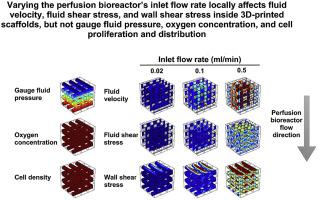Computers in Biology and Medicine ( IF 7.0 ) Pub Date : 2020-08-04 , DOI: 10.1016/j.compbiomed.2020.103826 Hadi Seddiqi 1 , Alireza Saatchi 2 , Ghassem Amoabediny 3 , Marco N Helder 4 , Sonia Abbasi Ravasjani 1 , Mohammadreza Safari Hajat Aghaei 1 , Jianfeng Jin 5 , Behrouz Zandieh-Doulabi 5 , Jenneke Klein-Nulend 5

|
Fluid flow dynamics and oxygen-concentration in 3D-printed scaffolds within perfusion bioreactors are sensitive to controllable bioreactor parameters such as inlet flow rate. Here we aimed to determine fluid flow dynamics, oxygen-concentration, and cell proliferation and distribution in 3D-printed scaffolds as a result of different inlet flow rates of perfusion bioreactors using experiments and finite element modeling. Pre-osteoblasts were treated with 1 h pulsating fluid flow with low (0.8 Pa; PFFlow) or high peak shear stress (6.5 Pa; PFFhigh), and nitric oxide (NO) production was measured to validate shear stress sensitivity. Computational analysis was performed to determine fluid flow between 3D-scaffold-strands at three inlet flow rates (0.02, 0.1, 0.5 ml/min) during 5 days. MC3T3-E1 pre-osteoblast proliferation, matrix production, and oxygen-consumption in response to fluid flow in 3D-printed scaffolds inside a perfusion bioreactor were experimentally assessed. PFFhigh more strongly stimulated NO production by pre-osteoblasts than PFFlow. 3D-simulation demonstrated that dependent on inlet flow rate, fluid velocity reached a maximum (50–1200 μm/s) between scaffold-strands, and fluid shear stress (0.5–4 mPa) and wall shear stress (0.5–20 mPa) on scaffold-strands surfaces. At all inlet flow rates, gauge fluid pressure and oxygen-concentration were similar. The simulated cell proliferation and distribution, and oxygen-concentration data were in good agreement with the experimental results. In conclusion, varying a perfusion bioreactor's inlet flow rate locally affects fluid velocity, fluid shear stress, and wall shear stress inside 3D-printed scaffolds, but not gauge fluid pressure, and oxygen-concentration, which seems crucial for optimized bone tissue engineering strategies using bioreactors, scaffolds, and cells.
中文翻译:

灌注生物反应器的入口流速影响流体流动动力学,但不影响3D打印骨骼组织工程支架中的氧气浓度:计算分析和实验验证。
灌注生物反应器内3D打印支架中的流体流动动力学和氧浓度对可控生物反应器参数(例如入口流速)敏感。在这里,我们旨在通过实验和有限元建模,确定灌注生物反应器的不同入口流速导致3D打印支架中的流体流动动力学,氧气浓度以及细胞增殖和分布。成骨细胞用低(0.8 Pa; PFF低)或高峰值剪切应力(6.5 Pa; PFF高)的脉动流体处理1 h),并测量一氧化氮(NO)的产生以验证剪切应力敏感性。在5天内进行了计算分析以确定3D支架链之间在三种入口流速(0.02、0.1、0.5 ml / min)之间的流体流动。实验评估了灌注生物反应器内部3D打印支架中MC3T3-E1成骨细胞的增殖,基质生成和耗氧量,以响应流体流动。高PFF比低PFF更强烈地刺激前成骨细胞产生NO。3D模拟表明,取决于入口流速,在脚手架之间,流体速度达到最大值(50–1200μm/ s),并且在3d模拟下流体剪切应力(0.5–4 mPa)和壁切应力(0.5–20 mPa)脚手架-钢绞线表面。在所有入口流量下,表压和氧气浓度均相似。模拟的细胞增殖和分布以及氧浓度数据与实验结果吻合良好。总之,改变灌注生物反应器的入口流速会局部影响3D打印支架内的流体速度,流体剪切应力和壁面剪切应力,但不会影响流体压力和氧气浓度,这对于采用以下方法优化骨组织工程策略而言至关重要生物反应器,支架和细胞。











































 京公网安备 11010802027423号
京公网安备 11010802027423号